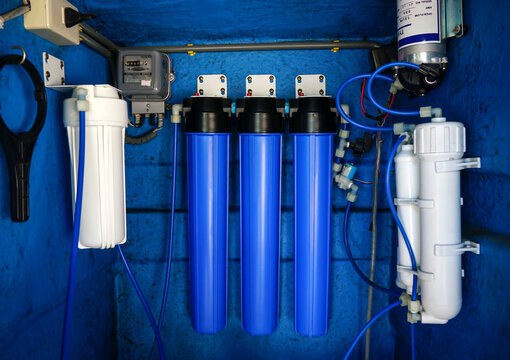Picking the ultimate whole-house water purification systems
Picking the ultimate whole-house water purification systems
Blog Article
We have found the article about Everything You Need to Know About Whole House Water Filter directly below on the net and think it made good sense to talk about it with you on my blog.

Entire residence water filters are the ideal option for individuals that want having a house that supplies clean, drinkable water. Along with giving top quality alcohol consumption water throughout your house, a whole house water filter additionally offers benefits such as removing contaminations that trigger spotting in water that is made use of to wash recipes. Unfiltered water can likewise cause trouble such as rusting plumbing and also home appliances, ruining clothing that is cleaned as well as discolor sinks or showers. Although whole residence water filters are typically used in household houses, they can also be an effective alternative for houses or workplaces.
Initially, it might seem that entire home water filters would be very costly when compared to various other filter options, however they are actually an extremely cost-effective alternative for water filtering. The price range of these water filters is big, starting at two hundred bucks and setting you back as long as one thousand dollars. The cost of the filters is dependent upon their dimension, material and also life span. This might seem like a very high price, however when compared with other filter options, it is really really budget-friendly as a result of the amount of filtering system that it provides.
Whole residence water filters purify water in the very same fashion that other filters, such as countertop or under sink filters, do. The difference is that it needs just one filter, which is affixed to the main water source, as opposed to requiring numerous water filters to be connected to various gadgets. As with the various other filters, whole house water filters purify faucet water forcibly it through several various phases of filtration. One of the stages is carbon filtering. Carbon is an effective technique of filtering system water due to the fact that it is porous and has the capability to eliminate little and also huge pollutants. Carbon is crucial in removing volatile organic carbon compounds, which sometimes can trigger severe damages to the liver, kidney or main nervous system. Carbon also removes harmful compounds such as pesticides, commercial solvents as well as insecticides.
One more vital step of the filtration process involves a process such as ionization or micron filtration. This step gets rid of thousands of impurities located in faucet water, as well as transforms the water to excellent sampling, healthy and balanced drinking water. As discussed earlier, the main advantage of whole house water filters are that they provide filtered water throughout the house with making use of just one filter.
One more advantage of whole house water filters is the lengthy life span that they supply. Most of these filters last in between fifty and also one hundred thousand gallons of water. For numerous, the main disadvantage of entire home filters is the more than average rate. Although these filters are extremely budget-friendly, they do need a large financial investment in advance. Whole residence water filters can additionally need a considerable amount job to set up.
How to Remove Iron Bacteria from Well Water
If your drinking water comes from a private well, you will likely experience issues with iron in your water. These issues can range from poor-tasting coffee to bright orange streaks in toilets and bathtubs. However, there’s an equally familiar but less understood problem linked to iron contamination: iron bacteria, also known as “iron-eating” or “iron-oxidizing” bacteria.
Iron is one of the most abundant minerals in the earth’s crust. As a result, elevated levels of iron are usually widespread in the groundwater that serves wells, often fostering the growth of iron bacteria in well water. These organisms can combine oxygen with iron, manganese, or other nutrients in the water to form a swampy sludge containing rust deposits, bacterial cells, and other organic and inorganic matter. This slimy residue then sticks the bacteria to pipes, pumps, plumbing fixtures, and appliances, causing clogging, foul tastes and odors, corroded pipes and plumbing fixtures, etc.
Well-water systems used infrequently or intermittently are typically more prone to iron bacteria problems. To make matters worse, removing these organisms from your water can be complicated, which is why we recommend taking steps to prevent them from forming in your well in the first place. Luckily, this article explains a highly effective way to remove iron bacteria from well water. Let’s start by discussing what iron bacteria are and how they get into well water.
Signs of Iron Bacteria in Water
If your household water supply is contaminated with iron bacteria, you might notice several unappealing signs that may indicate iron bacteria presence. These signs may include:
Stains and deposits on plumbing fixtures, pipes, and appliances
One of the most common indicators of iron bacteria in well water is stains and deposits on plumbing fixtures, pipes, and appliances. Water containing these organisms will leave rust-colored slime stains and deposits in sinks and toilets and inside well casings. You’ll also notice stains on fixtures, tableware, laundry, and various surfaces, that keep coming back no matter your cleaning method or efforts. These stains can be grey, yellow, or brown but are often a reddish-orange rust-like color.
Discoloration
Water containing iron bacteria can have a yellow, red, or orange hue. Further, visible deposits that have a clumpy or slimy consistency are very likely to have been caused by the presence of iron bacteria. Iron bacteria deposits are widespread in toilet tanks. In many cases, the deposits will take the form of a slimy coating along the walls of the tank. If the bacteria have been in the water for a lengthy period, the deposits could float in the water.
Oily sheen on the water surface
A quick and easy way to check for the presence of iron and other slimy-producing bacteria is to look in the water closet tank of your toilet. If you see an oily sheen on the surface of the water and can feel a slimy residue on the inside of the tank, slime-producing bacteria are likely present in your water system. If you use disinfectant in your tank, evidence of these conditions might not be so apparent.
https://www.springwellwater.com/how-to-remove-iron-bacteria-from-well-water/

Do you enjoy reading up on Everything You Need to Know About Whole House Water Filter? Create a review down below. We'd be interested to find out your views about this posting. We hope that you come back again later on. Are you aware of someone else who is intrigued by the niche? Do not hesitate to share it. We enjoy reading our article about Whole House Water Filtration.
Peace of mind? Dial! Report this page